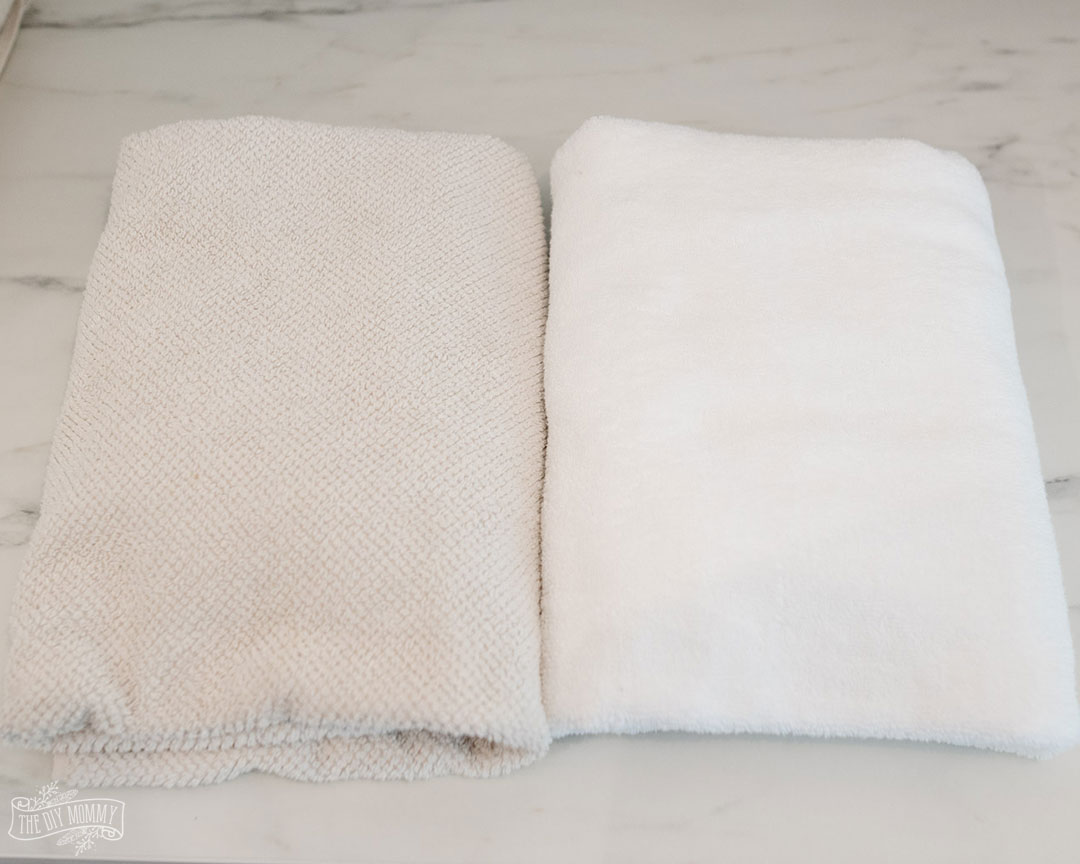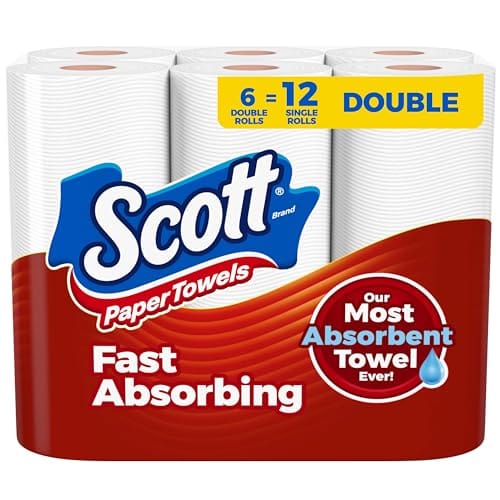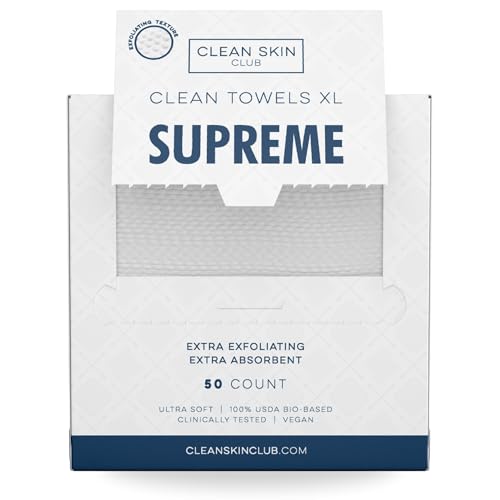To whiten towels, use baking soda and white vinegar in a hot wash cycle. Avoid fabric softeners and dryer sheets.
- The Secret To Brighter Towels
- Pre-wash Treatments That Work Wonders
- Choosing The Right Detergent
- The Power Of Baking Soda And Vinegar
- Bleach: Do's And Don'ts
- Laundry Boosters For Extra Whiteness
- Drying And Maintenance For Lasting Whiteness
- Troubleshooting Common Issues
- Frequently Asked Questions
- Conclusion
White towels can easily lose their brightness and become dingy over time. Regular laundering often isn’t enough to maintain their pristine appearance. Baking soda and white vinegar are powerful natural cleaners that can help restore the whiteness of your towels.
These household items not only brighten but also eliminate odors and residues. Using hot water enhances the cleaning power, ensuring a thorough wash. Skip the fabric softeners and dryer sheets, as they can leave a residue that dulls the fabric. By following these simple steps, your towels will stay fresh, soft, and brilliantly white.
The Secret To Brighter Towels
Everyone loves bright and fresh towels. They make your bathroom look clean and inviting. But how do you keep towels looking new? Let’s explore the secret to brighter towels.
Starting With Quality Linens
Choose towels made from high-quality cotton. Egyptian or Turkish cotton are good options. These types of cotton have longer fibers. Longer fibers mean softer and more absorbent towels.
Also, pay attention to the towel’s GSM (grams per square meter). A higher GSM indicates a thicker and more durable towel. Look for a GSM of 600 or more for the best quality.
Routine Care Tips
- Wash towels separately: Towels should not be washed with clothes. This prevents color transfer and lint issues.
- Avoid fabric softeners: Fabric softeners can reduce absorbency. Use white vinegar instead.
- Use warm water: Warm water helps remove dirt and bacteria.
- Dry towels properly: Shake towels before placing them in the dryer. This helps keep them fluffy.
Follow these tips to keep your towels bright and fresh. Quality linens and proper care make a big difference.
| Care Tip | Benefit |
|---|---|
| Wash towels separately | Prevents color transfer |
| Avoid fabric softeners | Keeps towels absorbent |
| Use warm water | Removes dirt and bacteria |
| Dry properly | Keeps towels fluffy |
Pre-wash Treatments That Work Wonders
Whitening towels can be a challenge. Pre-wash treatments can help. They prepare your towels for washing. This ensures they come out bright and fresh. Let’s explore some effective pre-wash treatments.
Soaking Strategies
Soaking your towels before washing is very important. It helps to loosen dirt and stains. Here are some effective soaking methods:
- Hot Water Soak: Fill a tub with hot water. Add your towels and let them soak for an hour.
- Vinegar Soak: Mix one cup of white vinegar with warm water. Soak your towels for 30 minutes.
- Baking Soda Soak: Add half a cup of baking soda to warm water. Soak the towels for 30 minutes.
Natural Ingredients For Pre-wash
Natural ingredients can be very effective. They are safe and eco-friendly. Here are some natural pre-wash treatments:
- Lemon Juice: Add half a cup of lemon juice to a bucket of water. Soak the towels for 30 minutes.
- Hydrogen Peroxide: Mix half a cup of hydrogen peroxide with water. Soak your towels for 30 minutes.
- White Vinegar: Use white vinegar as a pre-wash soak. It helps to remove smells and stains.
Choosing The Right Detergent
Finding the right detergent is crucial for keeping your towels white. The right detergent helps remove stains and keeps the fabric bright. Let’s explore the options available.
Chemical Vs. Natural Solutions
There are two main types of detergents: chemical and natural solutions. Both have their pros and cons.
| Type | Pros | Cons |
|---|---|---|
| Chemical |
|
|
| Natural |
|
|
Detergents Specifically For Whites
Some detergents are made just for white fabrics. These detergents contain special ingredients. They help keep your towels bright and free of yellowing.
When selecting a detergent for whites, look for these features:
- Optical Brighteners: These chemicals help reflect light, making whites appear brighter.
- Enzymes: They break down protein-based stains like food and sweat.
- Bleach Alternatives: Safer for fabrics, they still provide strong whitening power.
Using the right detergent can make all the difference. Your towels will stay fresh and white longer.

The Power Of Baking Soda And Vinegar
Struggling with dull, grimy towels? Discover the power of baking soda and vinegar. These household staples work wonders for whitening and softening towels. Let’s explore how each ingredient can help you achieve bright, fresh towels.
Brightening With Baking Soda
Baking soda is a natural cleanser. It helps remove stains and odors. To use, add half a cup of baking soda to your laundry load. This will help lift dirt and grime from your towels.
Baking soda also boosts your detergent’s power. This makes your towels cleaner and brighter. It’s an easy and affordable way to maintain your towels.
Vinegar As A Natural Fabric Softener
Vinegar is a natural fabric softener. It helps break down detergent residues. Add one cup of vinegar to your rinse cycle. This will leave your towels soft and fluffy.
Vinegar also neutralizes odors. It eliminates musty smells from your towels. It’s a simple solution for fresh, clean towels.
| Ingredient | Purpose | Amount | Cycle |
|---|---|---|---|
| Baking Soda | Stain Removal | 1/2 cup | Wash Cycle |
| Vinegar | Fabric Softening | 1 cup | Rinse Cycle |
Bleach: Do’s And Don’ts
Bleach can be a powerful tool for whitening towels. It removes stains and brightens fabric. But, using it incorrectly can damage your towels. Here are the do’s and don’ts of using bleach.
Using Bleach Safely
When using bleach, always wear gloves. It protects your skin. Dilute bleach with water before use. Never pour bleach directly on towels. Use a bleach dispenser in your washing machine. Follow the instructions on the bleach bottle. Never mix bleach with ammonia. It creates toxic fumes.
| Do’s | Don’ts |
|---|---|
| Read the label | Pour directly on towels |
| Wear gloves | Mix with ammonia |
| Use in a ventilated area | Use too much bleach |
Alternatives To Traditional Bleach
Not everyone likes using bleach. There are safer alternatives. Consider using baking soda. It whitens and freshens towels. Add a cup of baking soda to your wash. Another option is white vinegar. It softens towels and removes odors. Use a half-cup of white vinegar in the rinse cycle. Hydrogen peroxide is also a good bleach alternative. It disinfects and brightens towels. Use one cup of hydrogen peroxide in your wash.
- Baking soda: Whitens and freshens
- White vinegar: Softens and removes odors
- Hydrogen peroxide: Disinfects and brightens

Laundry Boosters For Extra Whiteness
Keeping towels bright and white can be challenging. Over time, towels tend to look dingy. Luckily, using laundry boosters can help. These simple methods use common household items. They can make a big difference in your laundry routine. Let’s explore two effective methods: Lemon Juice and Sunlight, and Hydrogen Peroxide for Stubborn Stains.
Lemon Juice And Sunlight
Lemon juice is a natural bleaching agent. It helps brighten your towels. To use lemon juice, follow these steps:
- Fill a large basin with hot water.
- Add the juice of two fresh lemons.
- Soak your towels in the mixture for an hour.
After soaking, wash the towels as usual. For even better results, dry them in sunlight. Sunlight acts as a natural whitener. It enhances the lemon juice effect. This method is eco-friendly and effective.
Hydrogen Peroxide For Stubborn Stains
Hydrogen peroxide is excellent for tough stains. It is safe and easy to use. Follow these steps for best results:
- Mix one part hydrogen peroxide with three parts water.
- Apply the solution directly to the stains.
- Let it sit for 30 minutes.
After treating the stains, wash the towels in hot water. Hydrogen peroxide removes stubborn stains and brightens the fabric. It is a powerful tool in your laundry arsenal.
Using these methods, you can maintain sparkling white towels. Both lemon juice and hydrogen peroxide are effective and safe. Try them and see the difference in your laundry.
Drying And Maintenance For Lasting Whiteness
Keeping your towels white requires proper drying and maintenance. These steps help prevent yellowing and maintain freshness. Follow these tips to ensure your towels stay bright and clean.
Proper Drying Techniques
Proper drying techniques are crucial for maintaining towel whiteness. First, shake out the towels before drying. This helps loosen any lingering dirt or detergent.
- Use a low heat setting: High heat can damage the fibers.
- Avoid overloading the dryer: This ensures even drying and reduces wrinkles.
- Add dryer balls: They help fluff the towels and speed up drying.
- Dry completely: Ensure towels are fully dry to prevent mildew.
Air drying is also an option. Hang towels in a sunny spot. Sunlight has natural bleaching properties. This keeps towels fresh and white.
Storing Towels To Prevent Yellowing
Correct storage can prevent yellowing. Follow these tips to store your towels properly.
- Store in a cool, dry place: Humidity can cause yellowing.
- Use breathable containers: Avoid plastic bags that trap moisture.
- Rotate towels regularly: Use all towels to prevent some from getting too old.
- Avoid fabric softeners: They can leave residues that cause yellowing.
For extra protection, add a sachet of baking soda or lavender. This helps absorb moisture and keeps towels smelling fresh.
Troubleshooting Common Issues
Keeping your towels white can be challenging. Sometimes, they develop issues like dinginess or set-in stains. This section will help you troubleshoot these common problems.
Dealing With Dinginess
Dingy towels can look unappealing. To restore their brightness, follow these steps:
- Use hot water: Wash towels in hot water to kill bacteria.
- Add vinegar: Pour one cup of white vinegar during the rinse cycle.
- Use baking soda: Add half a cup of baking soda to the wash cycle.
These steps help remove build-up and brighten your towels. For extra care, dry towels in the sun.
Removing Set-in Stains
Set-in stains can be stubborn. Follow these tips to get rid of them:
- Pre-treat stains: Apply a stain remover before washing.
- Soak in hot water: Soak the towels in hot water with detergent.
- Use a scrub brush: Gently scrub the stained area before washing.
These methods can help eliminate set-in stains effectively. Repeat if the stain persists.
| Problem | Solution |
|---|---|
| Dingy Towels | Hot water, vinegar, baking soda |
| Set-In Stains | Stain remover, hot water soak, scrubbing |

Frequently Asked Questions
How Can I Whiten Towels Naturally?
Use baking soda and white vinegar. Add 1 cup of baking soda to the wash cycle. Add 1 cup of white vinegar during the rinse cycle. This method is safe and effective.
What Causes Towels To Become Dingy?
Towels become dingy due to detergent buildup, hard water, and body oils. Regular washing with harsh chemicals can also cause discoloration. Proper care is crucial.
Can I Use Bleach To Whiten Towels?
Yes, but use it sparingly. Bleach can weaken towel fibers over time. Opt for oxygen-based bleach as a safer alternative. Always follow the manufacturer’s instructions.
How Often Should I Wash My Towels?
Wash towels every three to four uses. Frequent washing prevents bacteria buildup and keeps them fresh and clean. Proper washing helps maintain their whiteness.
Conclusion
Achieving brilliantly white towels is simpler than you think. Use these effective methods regularly for best results. Maintain a consistent cleaning routine to keep your towels fresh and bright. Always follow care instructions to prolong their lifespan. Enjoy the comfort of sparkling clean towels every day.
Happy laundering!


